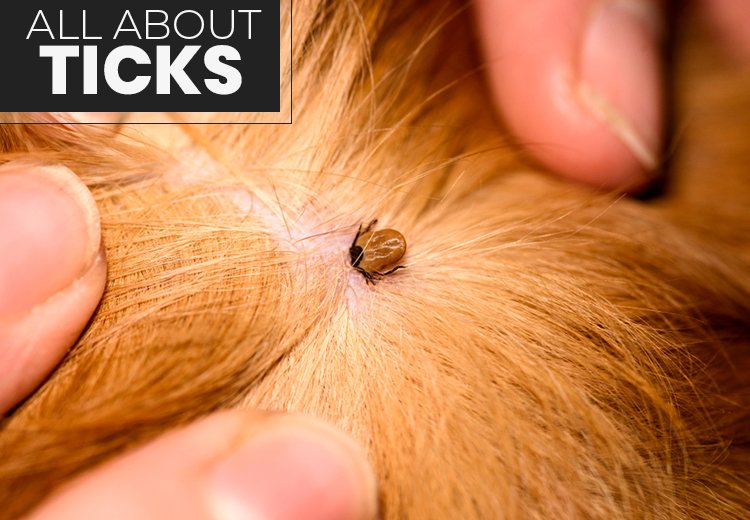The paralysis tick (Ixodes holocyclus)
In Australia, twelve tick species have been found on dogs and cats but only the paralysis tick (Ixodes Holocyclus) is a health hazard for small animals. Tick paralysis is a serious and potentially fatal condition requiring urgent veterinary attention. It is important to be aware of paralysis ticks and to actively protect your pets.
Life cycle of ticks.
It has a three host life cycle which means it needs to find a host and engorge on blood during each phase of its development (larva, nymph, adult) during the year.
Where are paralysis ticks found in Australia?
The paralysis tick is generally found on the eastern seaboard, from North Queensland down to Victoria. Ticks can also be found inland in suitable habitats. Native animals are the natural hosts.
Marsupials, birds and reptiles are the natural hosts of the paralysis. These native animals maintain the tick population in local scrub and bushland, and can also bring ticks into your yard while foraging at night if you live near bushland.
Paralysis ticks attach to any moving object that brush past them whilst they are on the leaves of shrubs and bushes. For this reason, we mostly find ticks on upper body parts such as lips, chin, around eyes, ear, back of head, neck, front legs and occasionally around the anus and between the toes.
When is "tick season" ?
In the north, paralysis ticks may be found all year round, while in the more southern areas, the season generally begins in spring and finishes in late autumn. Typically the tick season runs from late August through to February, reaching its peak between October and December.
However, tick season can be variable, starting earlier and ending later: for example, it may start early if the winter is mild.
THE SIGNS OF TICK POISONING
Typically, a case of tick poisoning goes through three stages.
Early signs
- A change in voice; the meow or bark becomes softer and/or changes pitch.
- Weakness in the back legs; walking along then sitting down suddenly is a common early sign.
- Vomiting, especially if it happens several times in a day and you see froth.
Later signs
- Wobbliness in the back legs.
- Excessive salivation and vomiting is not uncommon.
- Panting, progressing to loud breathing, even grunting noises.
- Many dogs will exhibit a moist cough and breathing problems before other signs. (Particularly common in King Charles spaniels, schnauzers and other short-nosed dogs, this is a dangerous sign because it may lead to pneumonia.)
Worsening signs
- As signs of poisoning progress, the animals become unable to stand.
- Breathing becomes exaggerated and difficult.
- As breathing becomes more difficult, the gums become cold and blue-tinged. Death follows quite quickly.
HOW DO I PROTECT MY PET FROM TICKS?
Pet owners must use a 4-step approach to protect their pets and reduce the risk of tick paralysis.
AVOID THE TICK HABITAT
During the tick season, don't take your dog walking in bush areas or scrub areas known to harbor ticks. Instead, limit your dog to exercising in well-mown grassed parks and footpaths. Keep lawns and shrubs short and remove compost material from backyards. Be aware of native animals entering your property.
SEARCH PETS EVERY DAY FOR TICKS
The most essential preventative measure is a thorough search of your dog's skin and coat at least once a day even if tick control products have been applied, as no product can provide 100% protection from ticks.
How do I search my pet?
A thorough systematic search for ticks is essential on a daily basis. The method and the diagrams below give you the best chance of finding a tick.
- Search pets thoroughly at least once a day; use the fingertips to feel through the animal's coat. Ticks or tick craters can be felt as lumps on the skin surface.
- Most ticks are found forward of the front legs, especially on the face, neck and ears . However, remember to search the entire pet.
- Start at your pet's nose and slowly examine the face, forehead and ears (outer and inner surface of the ear flap/pinna). Also search the eyes and lips and the skin/fur around the eyes and lips. Carefully examine all skin folds as well.
- Remove any collars and search the neck area thoroughly including the skin folds of the neck.
HOW DO I REMOVE A TICK?
If a tick is found it should be removed immediately. Your veterinarian can show you the best way to remove a tick, but we provide you with a step-by-step guide here.
- Aim to remove the tick by its head at the point of insertion into the pets skin. (See diagram below)
- When removing a tick, avoid disturbing the body of the tick (don't squeeze the body as this may inject more toxin into your pet).
- Do not apply methylated spirits, kerosene or turps to the attached tick as this may cause it to release more toxin before it dies.
- Contact your vet for advice.
- Take your pet to your vet or an emergency after-hours vet centre immediately if it is displaying any signs of illness.
- Take the tick in a jar to your vet to help with identification of the tick.
- Continue to search for more ticks as some animals can be infested with many ticks at one time
- A useful aid is a tick remover - a small 2-pronged fork like device that slides either side of the tick without touching the body of the tick and removes the tick easily.
Take care with pets that have had a tick removed
Even when you find a tick and remove it, your pet is still at risk of illness as the tick could have left a residue of poison under the skin which will then be slowly absorbed. You should watch your pet carefully for the next two to four days, keeping it cool and calm while avoiding excitement and exercise. Also, do not offer your pet either food or water because its ability to swallow may be impaired - talk to your vet.
APPLY PRODUCTS WITH TICK ACTIVITY- Your vet can advise you on the suitability of using one or a combination of tick-control products, depending on the risk of tick paralysis in your local area.
Important note:Never use any dog tick-control products on cats as some dog products are highly toxic to cats and can kill cats. Always check labels to be sure the product is suitable for cats.
PARALYSIS TICKS
What should you do if your pet shows symptoms of tick toxicity or if you find a crater or a tick on your dog?
Contact your vet immediately for advice or take your pet to your vet as soon as possible - tick paralysis is a serious and potentially fatal condition that requires veterinary attention. Keep the animal calm and do not offer food or water.
Stay calm and keep your pet calm and at a comfortable temperature (not too hot or cold).
Search for ticks and remove them as soon as possible (see removal tips above).
Do not offer food or water or give anything orally, pets affected by tick paralysis cannot protect their airway when they swallow (as a result of the toxin) and this may lead to aspiration of food/water into their airways which can cause aspiration pneumonia and serious breathing difficulties.
The paralysis tick injects a toxin into its host dog or cat as it feeds on your pet's blood.
How do paralysis ticks cause paralysis?
Paralysis ticks are dangerous parasites that can attach to pets and proceed to suck blood from them. As they suck the blood, they secrete a toxin into the pet. This toxin affects the nervous system leading to a number of symptoms (see below) and potentially death.
The toxin is not secreted in significant amounts until 2 to 3 days after attachment. Clinical signs of the animal being sick are often seen at day 3-4 with peak toxicity on days 5-6. These 3 days give owners and vets a chance to find and to remove ticks before they inject large amounts of toxin, causing symptoms and sometimes death.
Tick infested areas may continuously expose pets so they may develop some immune resistance however it only lasts for a couple of months and does not last until the next tick season.
What do paralysis ticks look like? How to tell a paralysis tick from other harmless ticks.
Paralysis ticks can look different depending on whether they are engorged with blood or not. When engorged with blood they have a blueish to light-grey/grey colour, ranging in size from two or three millimetres to as large as 10 millimetres. But even the smallest can cause paralysis.
- The middle 2 pairs of legs are lighter in colour, unlike the Bush tick and Brown Dog tick which have the same colour legs.
- Legs are “ bunched up ” at the front of the body
- They have a long mouth part which is called the “ snout ”
Any tick a quarter the size of your little fingernail or larger can be dangerous, even deadly.
Familiarise yourself with their appearance - check at your local vet clinic/vet clinic website, they will usually have posters and photos of paralysis ticks or do an online search for an image of Ixodes holocyclus.
BE AWARE OF THE SYMPTOMS OF TICK PARALYSIS (see above also)
- Loss of coordination in the hind legs (wobbliness in the back legs) or not being able to get up
- Grunting noises when breathing
- Weakness in the back legs
- Loss of appetite
- A change in the sound of the bark or voice
- Progressive paralysis to include the forelegs
- Retching, coughing (sometimes it is a moist cough), vomiting
- Difficulty breathing or rapid breathing
- Excessive salivation/drooling
- Any other abnormal behaviour or symptom
To learn much more about ticks and the danger they pose, click The Paralysis Tick of Australia.
PLAN FOR THE TICK SEASON
START YOUR TICK CONTROL AND TICK SEARCHERS EARLY
In the north, paralysis ticks may be found all year round, so tick management will be an all-year activity.
Further south, the tick season typically runs from late August through to February so you should use tick-control products and check pets at least between those months.
Talk to your vet when tick season is approaching so you know when tick activity starts in your area, so you can then be extra vigilant! Also ask your vet for advice on when tick activity has reduced at the end of the tick season.


























































_11132025_205157.png)

















